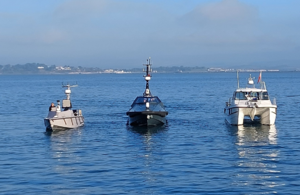Dstl trials autonomous maritime asset protection system (AMAPS)
The system could be used to defend high value assets whilst alongside in harbour, and to protect critical infrastructure.

Working with the Royal Navy, industry partners and the US Naval Undersea Warfare Centre, the Defence Science and Technology Laboratory (Dstl) conducted research to improve detection, tracking, classification and defeat capabilities against surface and subsurface threats to high value assets and critical infrastructure, using autonomous systems alongside traditional systems.
Dstl worked collaboratively with an industry consortium comprising QinetiQ, SeeByte, L3 Harris ASV and Thales, to develop a concept demonstrator based on open architectures and autonomous systems. This demonstrator was tested in a synthetic environment to ensure the viability of the concept before experimentation during a 2 week trial in Portland Harbour in October 2021 using Dstl’s containerised system and the Maritime Autonomy Surface Testbed vessel MAST-13.

Different levels of autonomy were evaluated, enabling a better assessment of the role that maritime autonomous systems can play in protecting vulnerable assets while also furthering understanding of the current maturity of the technology.
The trial successfully demonstrated end-to-end autonomy with the remote operation of a long range acoustic device and firing of a vessel arrestor system with the aim to stop a suspect craft.
Future trials will look to stress the system with the aim to assess robustness while completing interoperability tests with the US that were impacted by COVID-19.
Dstl Programme Manager, Alasdair Gilchrist MBE, commented:
The research showed the benefit of integrating multiple sensors, fixed and on uncrewed vessels (UXVs), into a common tactical picture to aid command decisions.
We have progressed maritime Artificial Intelligence/machine learning by developing apps that enable multiple UXVs to be command and controlled from a single operator to protect assets.
We have also developed algorithms to autonomously control and launch non-lethal effectors from uncrewed surface vessels (USVs) to deter aggressors and protect our valuable maritime assets.